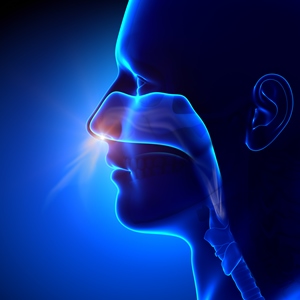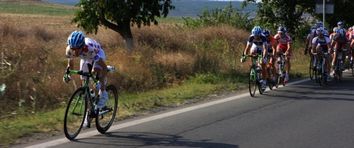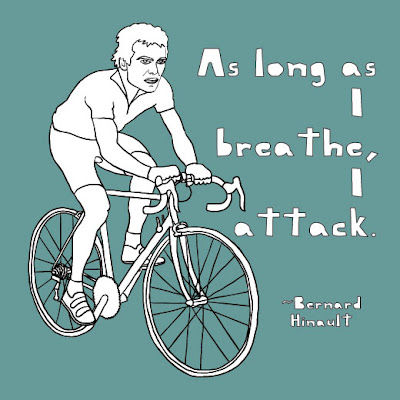After a recent trip to the dentist I started to re-consider the way I breathe while on and off the bike. My dentist talked highly about the benefits of 'nose breathing.' Apparently you should always breathe through your nose, especially while sleeping. Being a dentist, he was interested in protecting my teeth — mouth breathing at night can reduce saliva and result in dry mouth that can contribute to gum disease, bad breath, increased bacteria, and subsequent tooth decay and cavities — but mouth breathing also affects health beyond the mouth; it is a contributor to poor sleep, upper respiratory tract infections, ear and hearing problems, and asthma attacks.1
It occurred to me then that I never actually thought about 'how' I was breathing on the bike. I mainly concentrate on going fast and staying upright.
So, how should you breathe while riding? Through your nose? Mouth? Both nose and mouth? What about off the bike? And what are the pros and cons?
Benefits of nose breathing

Breathing through the nose optimizes the temperature and humidity of the air you take in. The nostrils and sinuses, critical parts of your respiratory system, also work to filter pollution before it reaches your lungs. A journal article by the Royal Liverpool Hospital, University Department of Otorhinolaryngology (yeh, I can’t pronounce that one, but it means ‘the study of diseases of the ear, nose, and throat’) stated, "Nasal breathing (as opposed to mouth breathing) increases circulation, blood oxygen and carbon dioxide levels, slows the breathing rate and improves overall lung volumes." Nose breathing helps balance the amount of oxygen and carbon dioxide in your blood. It also helps with your sleeping (you don’t get a dry mouth) and therefore your recovery off the bike.
Chronic mouth breathing while at rest or sleeping has a debilitating effect on energy levels, blood oxygenation, lymph drainage, sleep patterns, and the immune system.
Breathing while on the bike
Once I learned that nose breathing would be so beneficial, I tested it out on the bike. I failed dismally. It was near impossible to nose breathe while climbing or pushing hard.
To no surprise, further research shows that it is normal to breathe through your nose and mouth while exercising as the body aims to increase air intake and hence supply more oxygen to the muscles. Although nasal breathing is better than mouth breathing in terms of supplying oxygen to the body normally, it is not easy to do during intensive exercise that demands oxygen volume.
While cycling, it is preferable to inhale and exhale through the nose, but you are likely to get out of breath, as you won’t be able to keep up with the higher demand for oxygen. It’s faster to breathe through your mouth, but this reduces the amount of oxygen extracted from each breath. Make sense? Think of it this way: nose breathing gives you better oxygen distribution per breath, whereas mouth breathing gives more volume, but it is less useful, less efficient.
While on easy rides or segments, try nose breathing, but don’t stress if it’s impossible. When you have to breathe through your mouth, try taking slower, deeper breaths to give your lungs more time to work and ensure your muscles get all the oxygen they need to keep on pedaling. Shallow, fast breaths won’t get the oxygen to where it needs to go.
If you are riding in colder weather, you also may find it beneficial to nose breathe as this prevents cold, dry air from going straight to your lungs. If it's really cold, you can wear a scarf, facemask, or balaclava to help 'pre-warm' the air.
You might consider wearing a nasal strip or dilator. These strange looking contraptions can assist in widening the nasal passages to enable more air intake through the nose while riding. Alberto Contador and Chris Froome are amongst many pros and amateurs who do. As with most assistive technology, there are conflicting views and studies on whether or not these devices actually improve performance while on the bike. But if you're looking for an extra boost, even if it's only a placebo, it doesn't hurt to try. Sport performance aside, the research does seems to support benefits of using nasal strips or dilators during sleeping.
Whether breathing through your nose, mouth, or some combination, strive to be conscious of your breathing rate and breathe from your diaphragm and abdomen — what's known as "belly breathing." This draws more oxygen volume into the lungs to supply both physical and mental energy.
Breathing while sleeping
I know you want to hear about how to help your breathing on the bike, but bear with me. Changing the way you breathe at nighttime may help you be more rested, recover faster, and feel more energized in your training regime — you may become a better, stronger cyclist!
As covered before, mouth breathing at nighttime is not good. Breathing through your mouth can be a result of habit (perhaps a previous nose blockage), and existing nasal passage obstruction, or it could simply be related to genetics (your lips don’t meet or teeth overbite).
The main problem with nighttime mouth breathing is that you will get a dry mouth and tongue. That doesn’t sound too awful, but it means that it triggers the need to wake up and take a drink. The constant pattern of waking due to thirst means you end up being an unrested, grumpy person like my husband.
This is not good news for cycling training or for your teeth, general health, or well-being.
RELATED: Top 10 tips to training well
The previously mentioned products (nasal dilators, or nasal strips) can assist in opening your nasal passages while sleeping, which in turn may provide an adequate supply of oxygen through your nose to keep your mouth closed for restful sleep.
How to start nose breathing
I’m willing to try new techniques that will help my overall health, quality of sleep, and my cycling. If you are interested, you can train yourself to nose breathe by:
- Continuously reminding yourself to breath through your nose. Set up a phone reminder or post-it notes around the house.
- Practicing breathing exercises like the Buteyko Method, where you learn to breathe through your nose with the aid of an instructor.
- Slowing down and relaxing. Practice deep breathing to reduce stress, as stress can tense up the muscles, causing you to breathe shallower. This in turn causes physiologic changes that can aggravate nasal congestion.
Alternatively, you could do as my dentist does; he puts a piece of sticky tape over his mouth while sleeping to 'train' himself to breathe through his nose! (He recommends using standard sticky tape that easily un-sticks, not the strong stuff that could have bad consequences). His wife says it’s a bit freaky sleeping next to him all taped up...
If you are not keen on the sticky tape method, you can make it easier for yourself to nose breathe by reducing potential allergens (that block your nose) in the bedroom: change and clean bed linens regularly and remove pet hair from your pillows or bedding.
New York-based sleep and breathing expert Dr. Steven Park suggests you should clean our your nasal passages regularly. He says, "try using nasal saline sprays or a Nedi-pot, which uses gravity to pour salt water into your nose and sinuses. You can either use prepared saline packages or mix your own recipe (one cup of lukewarm water and 1/2 teaspoon of sea salt or Kosher salt with a pinch of baking soda)."2
DID YOU KNOW?
I have never heard this used before, but apparently the term ‘mouth breather’ can be a derogatory term for a ‘really dumb person,’ referring to someone who never learned to breathe through his or her nose and therefore lacks intelligence. Urban Dictionary
So, to get a solid night's sleep and recover better from your training sessions, work on nose breathing while sleeping. When on the bike, focus on breathing slowly and deeply during intense exercise and nose breathe as much as possible.

RELATED ARTICLE:
Become a stronger, faster climber
Climbing is a love or hate thing. With some work we can all become better climbers and perhaps even enjoy the challenge... READ MORE

RELATED ARTICLE:
A beginner's guide to interval training
Intervals done properly will increase your strength, speed and fitness. What are they and how can I adapt my regular ride in a simple way? READ MORE




